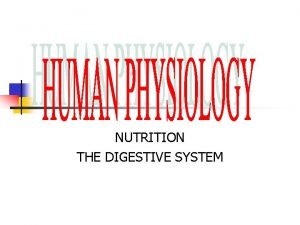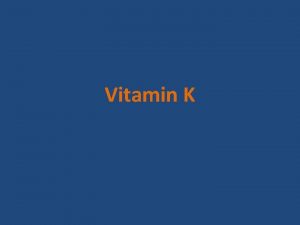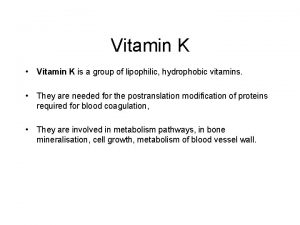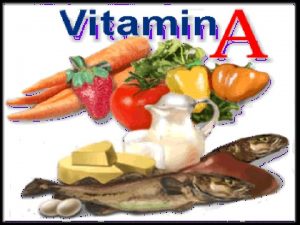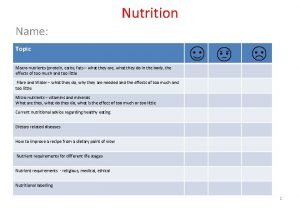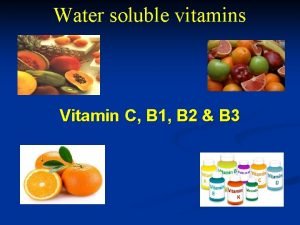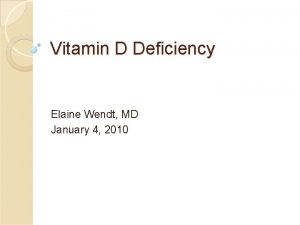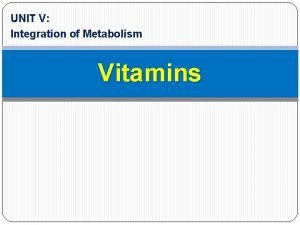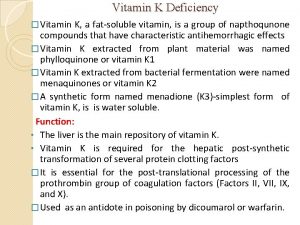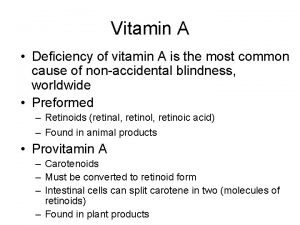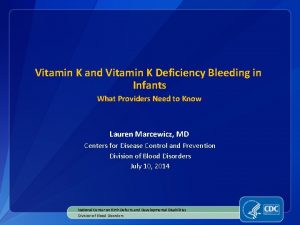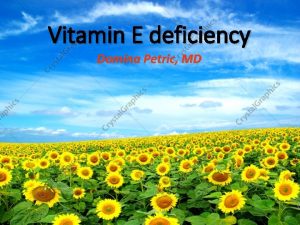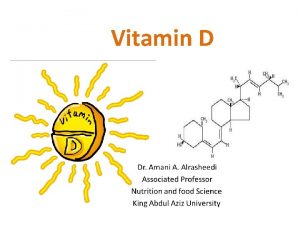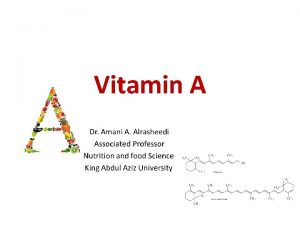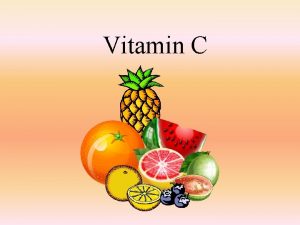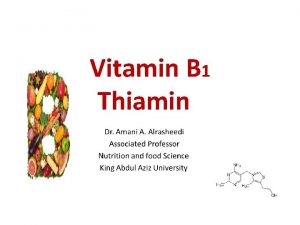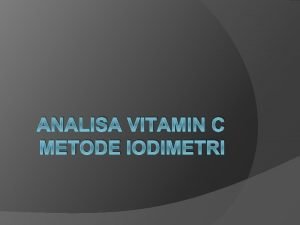Vitamin A deficiency Vitamin o The term vitamin














- Slides: 14

Vitamin A deficiency

Vitamin o The term vitamin was historically derived from "vitamine, " a combination word from vita and amine , meaning amine of life, because it was suggested in 1912 that the organic micronutrient food factors which prevented beri and perhaps other similar dietary-deficiency diseases, might be chemical amines.

Vitamin o vitamin is an organic compound required as a nutrient in tiny amounts by an organism o In other words, an organic chemical compound (or related set of compounds) is called a vitamin when it cannot be synthesized in sufficient quantities by an organism, and must be obtained from the diet.

Vitamins o Vitamins are classified as either water- soluble or fat soluble. o In humans there are 13 vitamins: 4 fat-soluble (A, D, E and K) 9 water-soluble (8 B vitamins and vitamin C which are dissolve easily in water, o Because they are not readily stored, consistent daily intake is important

Function Vitamins have diverse biochemical functions. o Some have hormone-like functions as regulators of mineral metabolism (e. g. vitamin D) o Regulators of cell and tissue growth and differentiation (e. g. some forms of vitamin A) o Others function as antioxidants e. g. vitamin E and sometimes vitamin C o The largest number of vitamins (e. g. B complex vitamins) function as precursors for enzyme cofactors , that help enzymes in their work as catalysts in metabolism.

Vitamin A deficiency o Vitamin A deficiency is a lack of vitamin A in humans. It is common in developing countries but rarely seen in developed countries o Night blindness is one of the first signs of vitamin A deficiency. o Night blindness is the difficulty for the eyes to adjust to dim light. Affected individuals are unable to distinguish images in low levels of illumination. People with night blindness have poor vision in the darkness, but see normally when adequate light is present.

Vitamin A deficiency o Xerophthalmia Which is a medical condition in which the eye fails to produce tears that leads to conjunctival dryness and damage, complete blindness can also occur since Vitamin A has a major role in phototransduction. o Phototransduction Is a process by which light is converted into electrical signals in the cells of the retina of the eye

Vitamin A deficiency o Vitamin A deficiency also diminishes the ability to fight infections. In countries where children are not immunized , infectious disease like measles have higher fatality rates. o Even mild, subclinical deficiency can also be a problem, as it may n n Increase children's risk of developing respiratory and diarrheal infections Decrease growth rate Slow bone development Decrease probability of survival from serious illness.

Causes of vitamin A deficiency o The major cause is diets which include few animal sources of pre-formed vitamin A. o Breast milk of a lactating mother with vitamin A deficiency contains little vitamin A , which provides a breast-fed child with too little vitamin A.

Causes of vitamin A deficiency o In addition to dietary problems, there are other causes of vitamin A deficiency n Iron deficiency can affect vitamin A uptake. n Excess alcohol consumption can deplete vitamin A stressed liver may be more susceptible to vitamin A toxicity.

Hypervitaminosis A o Hypervitaminosis A refers to the effects of excessive vitamin A (specifically retinoid) intake o Hypervitaminosis A occurs when the maximum limit for liver stores of retinoids is exceeded. o The excess vitamin A enters the circulation causing systemic toxicity. o Betacarotene (is an organic compound which is a strongly -coloured red-orange pigment abundant in plants and fruits. β-Carotene is also the substance in carrots that colours them orange) a precursor of vitamin A, is selectively converted into retinoids, so it does not cause toxicity.

Retinoids o The retinoids are a class of chemical compounds that are related chemically to vitamin A. o Retinoids are used in medicine, primarily due to the way they regulate epithelial cell growth. o Retinoids have many important and different functions throughout the body including n n n Roles in vision Regulation of cell proliferation and differentiation Growth of bone tissue Immune function Activation of tumor suppressor genes.

Hypervitaminosis A o Signs of acute toxicity include Nausea n Vomiting n Headache n Dizziness n Blurred vision n Loss of muscular coordination n

Hypervitaminosis A Other effects n n n Birth defects Liver problems Skin discoloration Hair loss Excessive skin dryness Angular cheilitis is an inflammatory lesion at the labial corner of the mouth, and often occurs bilaterally. The condition manifests as deep cracks or splits. In severe cases, the splits can bleed when the mouth is opened and shallow ulcers or a crust may form.
 Deficiency of vitamin
Deficiency of vitamin Vitamin k and pt
Vitamin k and pt Cholecalciferol vs calcitriol
Cholecalciferol vs calcitriol Factors necessary for erythropoiesis
Factors necessary for erythropoiesis K
K Cause of vitamin a
Cause of vitamin a Deficiency chart of macronutrients
Deficiency chart of macronutrients Uses of vitamin b2
Uses of vitamin b2 Vitamin k deficiency
Vitamin k deficiency Vitamin b sources and deficiency
Vitamin b sources and deficiency Pantothenic acid deficiency
Pantothenic acid deficiency Low on vitamin d
Low on vitamin d Vitamin c deficiency symptoms
Vitamin c deficiency symptoms Long term memory vs short term memory
Long term memory vs short term memory Term-to-term rule
Term-to-term rule
